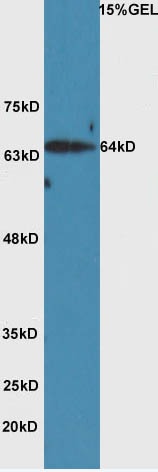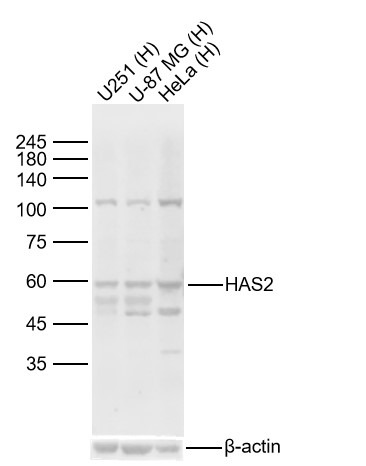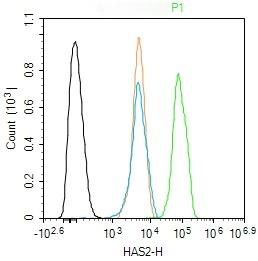Shopping Cart
Remove All Your shopping cart is currently empty
Your shopping cart is currently empty
Anti-HAS2 Polyclonal Antibody is a Rabbit antibody targeting HAS2. Anti-HAS2 Polyclonal Antibody can be used in FCM,WB.
| Pack Size | Price | USA Warehouse | Global Warehouse | Quantity |
|---|---|---|---|---|
| 50 μL | $222 | 7-10 days | 7-10 days | |
| 100 μL | $373 | 7-10 days | 7-10 days | |
| 200 μL | $527 | 7-10 days | 7-10 days |
| Description | Anti-HAS2 Polyclonal Antibody is a Rabbit antibody targeting HAS2. Anti-HAS2 Polyclonal Antibody can be used in FCM,WB. |
| Synonyms | Hyaluronic acid synthase 2 (HA synthase 2), Hyaluronate synthase 2, Hyaluronan synthase 2, Has2 |
| Ig Type | IgG |
| Reactivity | Human (predicted:Mouse,Rat,Chicken,Pig,Cow,Horse,Rabbit,Sheep) |
| Verified Activity | 1. Sample: Huh7 Cell (Human) Lysate at 40 μg Primary: Anti-HAS2 (TMAB-00830) at 1/300 dilution Secondary: HRP conjugated Goat-Anti-rabbit IgG (secondary antibody) at 1/5000 dilution Predicted band size: 64 kDa Observed band size: 64 kDa 2. Sample: Lane 1: Human U251 cell Lysates Lane 2: Human U-87 MG cell Lysates Lane 3: Human Hela cell Lysates Primary: Anti-HAS2 (TMAB-00830) at 1/1000 dilution Secondary: IRDye800CW Goat Anti-Rabbit IgG at 1/20000 dilution Predicted band size: 64 kDa Observed band size: 60 kDa 3. Blank control (black line): Hela. Primary Antibody (green line): Rabbit Anti-HAS2 antibody (TMAB-00830) Dilution: 1 μg/Test; Secondary Antibody (white blue line): Goat anti-rabbit IgG-AF488 Dilution: 0.5 μg/Test. Isotype control (orange line): Normal Rabbit IgG Protocol The cells were fixed with 4% PFA (10 min at room temperature) and then permeabilized with 90% ice-cold methanol for 20 min at-20°C, The cells were then incubated in 5% BSA to block non-specific protein-protein interactions for 30 min at room temperature. Cells stained with Primary Antibody for 30 min at room temperature. The secondary antibody used for 40 min at room temperature.    |
| Application | |
| Recommended Dose | WB: 1:500-2000; FCM: 1ug/Test |
| Antibody Type | Polyclonal |
| Host Species | Rabbit |
| Subcellular Localization | Membrane. |
| Tissue Specificity | Expressed in fibroblasts. |
| Construction | Polyclonal Antibody |
| Purification | Protein A purified |
| Appearance | Liquid |
| Formulation | 0.01M TBS (pH7.4) with 1% BSA, 0.02% Proclin300 and 50% Glycerol. |
| Concentration | 1 mg/mL |
| Research Background | Hyaluronan or hyaluronic acid (HA) is a high molecular weight unbranched polysaccharide synthesized by a wide variety of organisms from bacteria to mammals, and is a constituent of the extracellular matrix. It consists of alternating glucuronic acid and N-acetylglucosamine residues that are linked by beta-1-3 and beta-1-4 glycosidic bonds. HA is synthesized by membrane-bound synthase at the inner surface of the plasma membrane, and the chains are extruded through pore-like structures into the extracellular space. It serves a variety of functions, including space filling, lubrication of joints, and provision of a matrix through which cells can migrate. HA is actively produced during wound healing and tissue repair to provide a framework for ingrowth of blood vessels and fibroblasts. Changes in the serum concentration of HA are associated with inflammatory and degenerative arthropathies such as rheumatoid arthritis. In addition, the interaction of HA with the leukocyte receptor CD44 is important in tissue-specific homing by leukocytes, and overexpression of HA receptors has been correlated with tumor metastasis. HAS2 is a member of the newly identified vertebrate gene family encoding putative hyaluronan synthases, and its amino acid sequence shows significant homology to glycosaminoglycan synthetase (DG42) from Xenopus laevis, and human and murine hyaluronan synthase 1. [provided by RefSeq, Jul 2008] |
| Immunogen | KLH conjugated synthetic peptide: human HAS2/Hyaluronan synthase 2 |
| Antigen Species | Human |
| Gene Name | HAS2 |
| Gene ID | |
| Protein Name | Hyaluronan synthase 2 |
| Uniprot ID | |
| Function | Plays a role in hyaluronan/hyaluronic acid (HA) synthesis. |
| Molecular Weight | Theoretical: 64 kDa. |
| Stability & Storage | Store at -20°C or -80°C for 12 months. Avoid repeated freeze-thaw cycles. |
| Transport | Shipping with blue ice. |
| Size | Quantity | Unit Price | Amount | Operation |
|---|

Copyright © 2015-2026 TargetMol Chemicals Inc. All Rights Reserved.